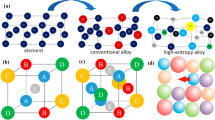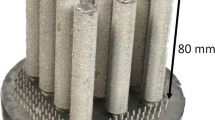Abstract
Evolution of microstructure and texture during severe deformation and annealing was studied in Al-2.5%Mg alloy processed by two different routes, namely, monotonic Accumulative Roll Bonding (ARB) and a hybrid route combining ARB and conventional rolling (CR). For this purpose Al-2.5%Mg sheets were subjected to 5 cycles of monotonic ARB (equivalent strain (εeq) = 4.0) processing while in the hybrid route (ARB + CR) 3 cycle ARB-processed sheets were further deformed by conventional rolling to 75% reduction in thickness (εeq = 4.0). Although formation of ultrafine structure was observed in the two processing routes, the monotonic ARB—processed material showed finer microstructure but weak texture as compared to the ARB + CR—processed material. After complete recrystallization, the ARB + CR-processed material showed weak cube texture ({001}〈100〉) but the cube component was almost negligible in the monotonic ARB-processed material-processed material. However, the ND-rotated cube components were stronger in the monotonic ARB-processed material-processed material. The observed differences in the microstructure and texture evolution during deformation and annealing could be explained by the characteristic differences of the two processing routes.








Similar content being viewed by others
References
R.Z. Valiev and T.G. Langdon, Principles of Equal-Channel Angular Pressing as a Processing Tool for Grain Refinement, Progress Mater. Sci., 2006, 51(7), p 881–981
A.P. Zhilyaev and T.G. Langdon, Using High-Pressure Torsion for Metal Processing: Fundamentals and Applications, Progress Mater. Sci., 2008, 53(6), p 893–979
R.Z. Valiev, R.K. Islamgaliev, and I.V. Alexandrov, Bulk Nanostructured Materials From Severe Plastic Deformation, Progress Mater. Sci., 2000, 45(2), p 103–189
B.L. Li, N. Tsuji, and N. Kamikawa, Microstructure Homogeneity in Various Metallic Materials Heavily Deformed by Accumulative Roll-Bonding, Mater. Sci. Eng. A, 2006, 423(1–2), p 331–342
X. Huang et al., Microstructural Evolution During Accumulative Roll-Bonding of Commercial Purity Aluminum, Mater. Sci. Eng. A, 2003, 340(1–2), p 265–271
X.L. Li et al., Development of the Cube Texture at Low Annealing Temperatures in Highly Rolled Pure Nickel, Acta Mater., 2007, 55(10), p 3531–3540
P.P. Bhattacharjee, R.K. Ray, and N. Tsuji, Cold Rolling and Recrystallization Textures of a Ni-5 at.% W Alloy, Acta Mater., 2009, 57(7), p 2166–2179
N. Hansen and D.J. Jensen, Development of Microstructure in FCC Metals During Cold Work, Philos. Trans. R Soc. Lond. Ser. A, 1999, 357(1756), p 1447–1469
N. Kamikawa, N. Tsuji, and Y. Minamino, Microstructure and Texture Through Thickness of Ultralow Carbon IF Steel Sheet Severely Deformed by Accumulative Roll-Bonding, Sci. Technol. Adv. Mater., 2004, 5(1–2), p 163–172
O. Engler, On the Origin of the R Orientation in the Recrystallization Textures of Aluminum Alloys, Metall. Mater. Trans. A, 1999, 30(6), p 1517–1527
R.D. Doherty et al., Current Issues in Recrystallization: A Review, Mater. Sci. Eng. A, 1997, 238(2), p 219–274
A.A. Ridha and W.B. Hutchinson, Recrystallization Mechanisms and the Origin of Cube Texture in Copper, Acta Metall., 1982, 30(10), p 1929–1939
O. Engler, An EBSD Local Texture Study on the Nucleation of Recrystallization at Shear Bands in the Alloy Al-3%Mg, Scripta Mater., 2001, 44(2), p 229–236
O. Engler, J. Hirsch, and K. Lücke, Texture Development in Al-1.8 wt% Cu Depending on the Precipitation State-II. Recrystallization Textures, Acta Metall. Mater., 1995, 43(1), p 121–138
O. Engler, Nucleation and Growth During Recrystallisation of Aluminium Alloys Investigated by Local Texture Analysis, Mater. Sci. Technol., 1996, 12(10), p 859–872
Acknowledgment
The authors would like to acknowledge the financial support of DST, India (Grant No. SR/FTP/ETA-126/2010) for the research work.
Author information
Authors and Affiliations
Corresponding author
Rights and permissions
About this article
Cite this article
Gatti, J.R., Bhattacharjee, P.P. Microstructure and Texture of Al-2.5wt.%Mg Processed by Combining Accumulative Roll Bonding and Conventional Rolling. J. of Materi Eng and Perform 23, 4453–4462 (2014). https://doi.org/10.1007/s11665-014-1237-8
Received:
Revised:
Published:
Issue Date:
DOI: https://doi.org/10.1007/s11665-014-1237-8




